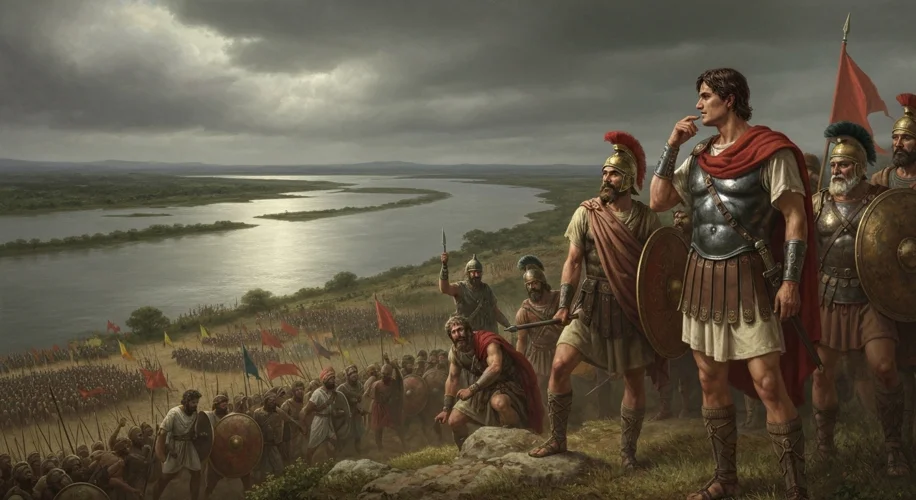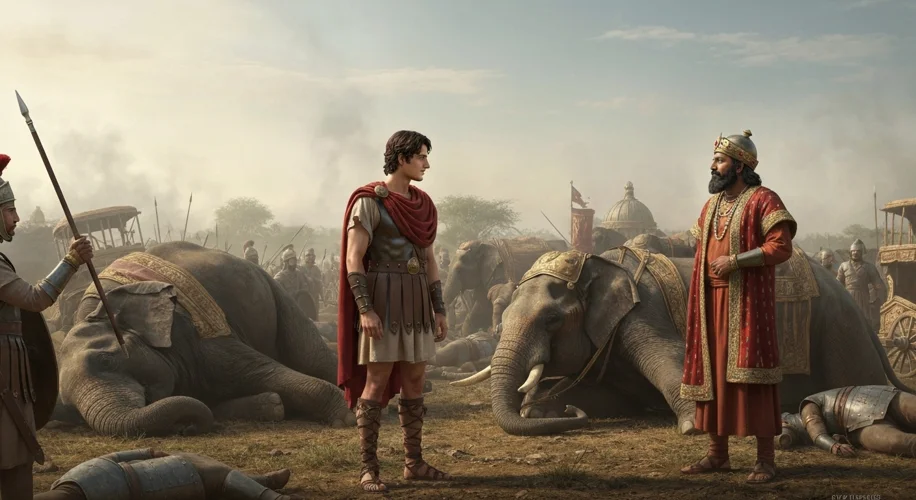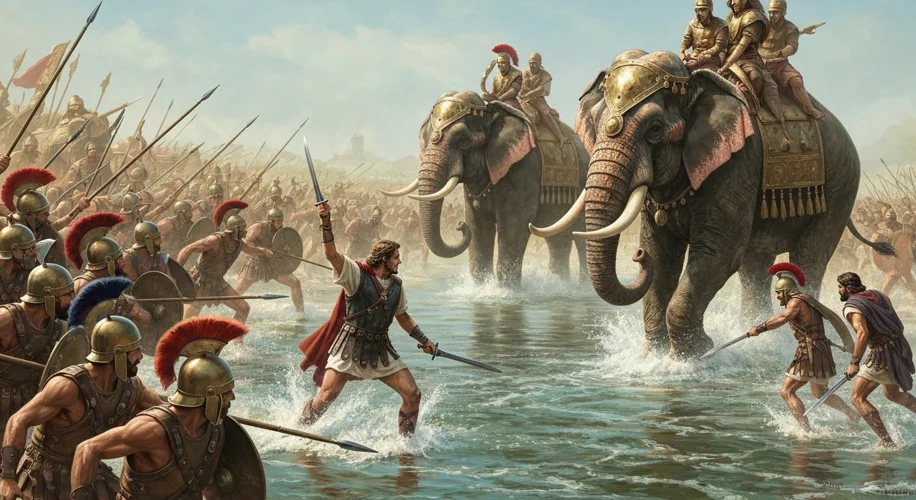Picture this: the sweltering heat of the Indian subcontinent, the air thick with anticipation and the scent of dust. On one side of the mighty Hydaspes River, a vast army, battle-hardened and victorious, led by the greatest conqueror the world had yet known – Alexander the Great. On the other, across the churning, formidable waters, stood a king and his army, ready to defend their homeland with a ferocity that would shock even the Macedonians. This was the stage set for the Battle of the Hydaspes in 326 BCE, a clash that would test Alexander’s legendary strategic genius and his personal courage against an unconventional and terrifying foe.
A World Divided
By 326 BCE, Alexander had carved a path of conquest from Greece to Persia, his name echoing through the ancient world as a symbol of invincibility. His Macedonian phalanx, a formidable force of tightly packed spearmen, was virtually unmatched. Yet, as he pushed eastward into the Punjab region of what is now Pakistan, he encountered a civilization with its own rich history and advanced military traditions. The kingdoms of India, particularly the powerful realm of King Porus (or Paurava), were vastly different from the empires he had previously subdued. The very landscape – dense forests and powerful rivers like the Hydaspes – presented new challenges.
Porus himself was a king of considerable stature, described by ancient historians as a man of imposing physique and indomitable spirit. He ruled a prosperous kingdom and commanded an army that, while perhaps not as experienced in continuous warfare as Alexander’s, possessed a potent and terrifying new weapon: war elephants. These colossal beasts, armored and carrying towers filled with archers and javelin throwers, were a psychological and physical force unknown to Alexander’s European-trained troops.
The Uncharted Frontier
Alexander’s campaign into India was driven by a thirst for knowledge and glory, a desire to reach the ‘ends of the earth.’ He had already defeated the Persian Empire and sought to bring the regions beyond it under his control. His arrival in India was met with a mixture of awe and resistance. Many local rulers submitted, but Porus, a proud and independent monarch, resolved to stand his ground. The Hydaspes River, swollen by monsoon rains, became the natural barrier and the chosen battlefield.
The Stalemate and the Bold Gambit
Alexander, ever the strategist, faced a dilemma. The Hydaspes was too wide and swift to cross with his entire army in one go, especially under the watchful eyes of Porus’s vigilant troops stationed on the opposite bank. He attempted several feints, moving troops up and down the river to probe for weaknesses and demoralize the enemy, but Porus skillfully countered each move, keeping his forces concentrated. The tension must have been palpable – for weeks, the two armies faced each other, separated by the raging river, each assessing the other, each waiting for a mistake.

Porus, meanwhile, was confident in his position and his elephants. He had arrayed his army with the elephants forming a formidable front line, designed to break the Macedonian charge. He likely saw the elephants as an insurmountable obstacle, a living wall that would shatter Alexander’s famed infantry and cavalry.
The Daring Crossing
Alexander, refusing to be deterred, conceived a daring plan. Under the cover of a stormy night, he led a significant portion of his army several miles upstream. Using boats and makeshift rafts, they attempted a difficult and dangerous crossing of the Hydaspes. The sound of the storm and the darkness concealed their movement, but the risk was immense. As they landed on the far bank, they were immediately engaged by Porus’s scouts, alerting the main Indian army.
Porus dispatched his son to confront the landing Macedonians, but he was killed in the ensuing skirmish. Porus then advanced with his main force, including his formidable elephant corps. The battle commenced with Alexander’s cavalry launching a devastating charge, aiming to outflank the Indian infantry. However, the elephants proved to be a disruptive force. Their sheer size and terrifying trumpeting threw the Macedonian horses into a frenzy, and the tightly packed phalanx struggled to maintain formation as the beasts crashed into their ranks.

The fighting was brutal and chaotic. The Macedonians, unable to break the elephant line directly, resorted to targeting the mahouts (elephant drivers) and the beasts themselves with javelins and arrows. Wounded and maddened, the elephants turned on both sides, adding to the carnage. Alexander, ever the warrior-king, fought at the forefront, his legendary horse Bucephalus distinguishing itself in the melee. He personally engaged Porus in a dramatic duel, though the exact nature of this confrontation is debated by historians.
Victory and a Respected Foe
Despite the ferocity of the Indian resistance and the terror of the elephants, Alexander’s superior tactics and the discipline of his troops ultimately prevailed. The Indian infantry was routed, and the elephants, though causing immense damage, were eventually overcome or driven back. Porus himself, wounded and dismounted, was captured. Legend has it that when asked how he wished to be treated, Porus replied, “Treat me as a king, Alexander.” Impressed by his adversary’s valor, Alexander not only spared him but reinstated him as ruler of his kingdom, forging an alliance that would prove valuable.

The Battle of the Hydaspes was one of Alexander’s most hard-fought victories. It marked the easternmost extent of his conquests, as his weary troops, unnerved by the prospect of facing even larger Indian armies further east, eventually mutinied and refused to advance. Alexander, though disappointed, had to turn back, his ambitions in India curtailed not by defeat, but by the limits of his own army’s endurance.
A Turning Point in the East
The Battle of the Hydaspes was more than just another victory for Alexander. It was a brutal introduction to the unique challenges of Indian warfare and a testament to the adaptability of his army. The elephant proved to be a powerful, albeit unpredictable, weapon. The battle showcased Alexander’s strategic brilliance in executing a complex river crossing under duress and his personal bravery in the face of overwhelming odds.
More significantly, the encounter with Porus fostered a mutual respect that transcended the battlefield. Alexander recognized the strength and dignity of the Indian king, choosing alliance over subjugation. This engagement also marked a crucial moment where Alexander’s seemingly unstoppable march was finally halted by the sheer will of his soldiers to return home. The Battle of the Hydaspes stands as a vivid example of a clash of civilizations, where courage, strategy, and the sheer terror of the unknown met on the banks of a mighty river, forever etching Alexander’s campaign into the annals of military history.

